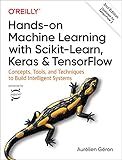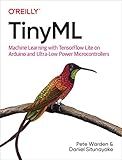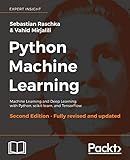Best TensorFlow Variable Manipulation Guides to Buy in December 2025

Hands-On Machine Learning with Scikit-Learn, Keras, and TensorFlow: Concepts, Tools, and Techniques to Build Intelligent Systems
- MASTER END-TO-END ML PROJECTS WITH SCIKIT-LEARN EXPERTISE.
- EXPLORE DIVERSE MODELS: SVMS, TREES, AND ENSEMBLE METHODS.
- BUILD CUTTING-EDGE NEURAL NETS USING TENSORFLOW AND KERAS.



Hands-On Machine Learning with Scikit-Learn, Keras, and TensorFlow: Concepts, Tools, and Techniques to Build Intelligent Systems



Deep Learning with TensorFlow and Keras: Build and deploy supervised, unsupervised, deep, and reinforcement learning models, 3rd Edition



Python Machine Learning: Machine Learning and Deep Learning with Python, scikit-learn, and TensorFlow 2, 3rd Edition



TinyML: Machine Learning with TensorFlow Lite on Arduino and Ultra-Low-Power Microcontrollers



Hands-On Machine Learning with Scikit-Learn and TensorFlow: Concepts, Tools, and Techniques to Build Intelligent Systems



Python Machine Learning - Second Edition: Machine Learning and Deep Learning with Python, scikit-learn, and TensorFlow


In TensorFlow, variables are used to hold and update the trainable parameters of a model during the training process. They are essential for building and training neural networks. Here are some ways to manipulate variables in TensorFlow:
- Variable Creation: To create a variable, you typically use the tf.Variable() function. This function takes an initial value for the variable and returns a new TensorFlow variable object. For example:
my_variable = tf.Variable(initial_value)
- Variable Initialization: Before you can use a variable, you need to initialize it. This can be done using the tf.compat.v1.global_variables_initializer() function. It initializes all variables in the TensorFlow graph. For example:
init = tf.compat.v1.global_variables_initializer() sess.run(init)
- Variable Assignment: You can assign a new value to a variable using the assign() method or the assign_add() and assign_sub() methods. For example:
assign_op = my_variable.assign(new_value)
assign_add_op = my_variable.assign_add(value_to_add)
- Variable Updating: During the training process, you often update variables based on gradients calculated during backpropagation. This can be done using the tf.GradientTape() context. For example:
with tf.GradientTape() as tape: # Perform forward pass and calculate loss loss = model(x)
Compute gradients
grads = tape.gradient(loss, model.trainable_variables)
Update variables using an optimizer
optimizer.apply_gradients(zip(grads, model.trainable_variables))
- Variable Saving and Restoring: TensorFlow provides methods to save and restore variables from checkpoints. This allows you to save and restore the state of variables at different stages of training. For example:
# Saving variables saver = tf.compat.v1.train.Saver() saver.save(sess, 'my_model.ckpt')
Restoring variables
saver = tf.compat.v1.train.Saver() saver.restore(sess, 'my_model.ckpt')
These are some of the common ways to manipulate variables in TensorFlow. Variables are essential for building and training models, and understanding how to manipulate them is crucial for TensorFlow developers.
What is the significance of trainable parameter sharing in TensorFlow?
The significance of trainable parameter sharing in TensorFlow is that it allows multiple models or layers within a model to share the same set of parameters. This is particularly useful in cases where the models or layers have similar functionality or need to learn similar features, as it can lead to improved generalization, better utilization of data, and reduced overall model complexity.
By sharing parameters, the models or layers can benefit from the collective knowledge learned from different parts of the network. This can help in cases where there is limited data available, as it allows the model to generalize better by borrowing information from other similar tasks or layers.
Additionally, sharing parameters can reduce the number of trainable parameters in the model, leading to faster training times and reduced memory requirements. It also allows the model to be more efficient and computationally cheaper during inference, as the shared parameters can be reused across multiple instances.
Overall, trainable parameter sharing in TensorFlow enables more efficient and effective learning by leveraging shared knowledge and reducing the complexity of the model.
How to debug issues related to variables in TensorFlow?
Debugging TensorFlow variables can be a bit tricky, but there are several techniques you can use to identify and resolve issues related to variables. Here are some steps you can follow:
- Check variable type: Make sure the variable you are working with has the correct data type. TensorFlow has several data types (e.g., float32, int32) that must be consistent across all operations involving the variable.
- Verify variable shape: Ensure the shape of the variable is compatible with the operations you are performing. Many TensorFlow operations require specific shapes, and mismatches can lead to errors.
- Print or log variable values: Insert print statements or use TensorFlow's logging capabilities to inspect the values of your variables during execution. This can help you identify unexpected values or changes when debugging.
- Gradually reduce complexity: If you notice issues with a complex model or large dataset, try reducing the complexity or size of your code/data to isolate the problem. Simplifying the problem often allows for more focused debugging.
- Use tf.debugging: TensorFlow provides a debugging module called tf.debugging that offers various helpful tools. You can use tf.debugging.assert_* functions to check variable conditions during execution, and tf.debugging.enable_check_numerics to catch NaN or Inf values.
- Apply eager execution: Enable TensorFlow's eager execution mode, which allows for immediate evaluation of operations and variables. This can simplify debugging, as variables and their values are readily accessible and can be examined more interactively.
- Use a debugger: TensorFlow integrates well with popular Python debuggers such as pdb or PyCharm. By setting breakpoints and stepping through the code, you can closely examine the flow of execution and variable values at each step.
- Cross-check with minimal example: Try to recreate the issue in a minimal code setup. By isolating the problem, you may spot any hidden bugs that were masked by the complexity of your original code.
Remember, debugging TensorFlow code often requires trial and error. Through a combination of print statements, logging, careful inspection of shapes and types, and stepping through the code, you can track down and fix issues related to variables.
How to assign values to variables in TensorFlow?
In TensorFlow, you can assign values to variables using the tf.Variable class. Here's an example of how you can do it:
import tensorflow as tf
Defining a variable with an initial value of 0
my_variable = tf.Variable(0, name='my_variable')
Assigning a new value to the variable
assign_op = tf.assign(my_variable, 10)
Initializing the variable
init_op = tf.global_variables_initializer()
Creating a TensorFlow session
with tf.Session() as sess: # Running the initialization operation sess.run(init_op)
# Printing the initial value of the variable
print("Initial value:", sess.run(my\_variable))
# Assigning a new value to the variable
sess.run(assign\_op)
# Printing the updated value of the variable
print("Updated value:", sess.run(my\_variable))
In this example, tf.Variable(0) creates a variable with an initial value of 0. Then, tf.assign(my_variable, 10) updates the value of my_variable to 10. Finally, sess.run() is used to evaluate and print the values of the variable inside a TensorFlow session.
Note that you need to initialize the variables before using them, which is done using tf.global_variables_initializer().
